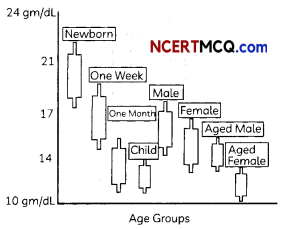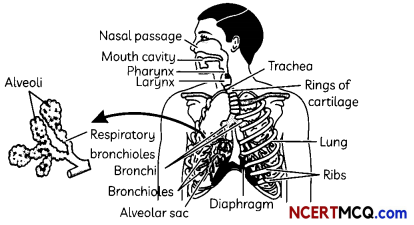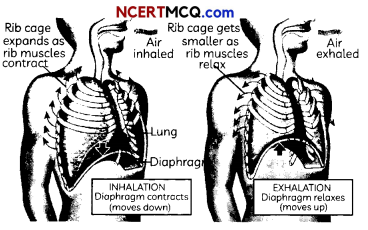Respiration
Respiration is a biochemical process taking place in the mitochondria and involves exchange of gases oxygen and carbon dioxide and oxidation of food in celLs to release energy. Respiration is essential for life because it provides energy for carrying out all the life processes which are necessary to keep the organisms alive.
Mechanism of Respiration
The first step is the break-down of glucose, a six-carbon molecule, into a three-carbon molecuLe called pyruvate. This process takes place in the cytoplasm.
1. The pyruvate may be converted into ethanol and carbon dioxide. This process takes place in yeast during fermentation. Since this process takes place in the absence of air (oxygen), it is called anaerobic respiration.
2. Breakdown of pyruvate using oxygen takes place in the mitochondria. This process breaks up the three-carbon pyruvate molecule to give three molecules of carbon dioxide and water. Since this process takes place in the presence of air (oxygen), it is called aerobic respiration.
3. Why sometimes we get cramps: Sometimes, when there is a lack of oxygen in our muscle cells, the pyruvate is converted into lactic acid which is also a three-carbon molecule. This build-up of lactic acid in our muscles during sudden activity causes cramps.

4. The energy released during cellular respiration is immediately used to synthesize a molecule called ATP which is the energy currency for most cellular processes. The energy released during the process of respiration is used to make an ATP molecule from ADP and inorganic phosphate.
5. ATP can be used in the cells for the contraction of muscles, protein synthesis, conduction of nervous impulses and many other activities. The aerobic organisms need to ensure that there is sufficient intake of oxygen.
![]()
Differences between Aerobic and Anaerobic Respiration
| Aerobic Respiration | Anaerobic Respiration |
| 1. It takes place in the presence of oxygen | 1. It takes place in absence of oxygen. |
| 2. End products are carbon dioxide and water | 2. End products may be lactic acid (in muscles of animals) or alcohol (in some plants). |
| 3. Considerable energy is released | 3. Much less energy is released. |
| 4. The pyruvate formed by glycolysis of glucose in cytopLasm, goes through Krebs cycle and forms water and carbon dioxide | 4. The pyruvate formed by glycolysis of glucose in the cytoplasm undergoes fermentation and forms ethyl alcohol. |
| 5. Majority of organisms use this mode of respiration | 5. Some organisms such as certain bacteria and yeast use this mode of respiration. |
Respiration in Plants and in Animals
| Respiration in Plants | Respiration in Animals |
| 1. All parts of a plant like a root, stem. Leaf perform respiration individually | 1. Respiration takes place by respiratory organs only. such as skin, gills. spiractes or lungs. |
| 2. There is little transport of gases from one part of the plant to another | 2. There is complete transport of respiratory gases from one part to another. |
| 3. Rate of respiration is quite slow | 3. Rate of respiration is fast. |
Exchange of Gases in Plants
| Plant Organ | Exchange of Gases |
| Roots | Oxygen diffuses into root hairs, which are in contact with oxygen in the soil, and passes into other cells of the root. Similarly, carbon dioxide diffuses from root cells into the soil. |
| Older portions of root | Exchange of gases takes place through tiny openings, called lenticels, on the layer of dead cells as older portions of the root do not have root hairs. |
| Stem | In woody plants. the bark has lenticeLs through which exchange of gases take place. |
| Leaves | Leaves have tiny apertures called stomata through which diffusion of oxygen and carbon dioxide takes place. |
Respiration in Plants
1. Plants exchange gases through stomata, and the large intercellular spaces ensure that all cells are in contact with air. Carbon dioxide and oxygen ore are exchanged by diffusion here. They can go into cells. or away from them and out into the air. The direction of diffusion depends upon the environmental conditions and the requirements of the plant,
2. At night, when there is no photosynthesis occurring. CO2 elimination is the major exchange activity going on. During the day, CO2 generated during respiration is used up for photosynthesis. hence there is no CO2 release. Instead, oxygen release is the major event at this time.
![]()
Respiration in Animals
Animals have specific organs for respiration. All respiratory organs have three common features:
- A large. fine and delicate surface area to get enough oxygen.
- Thin walls for easy diffusion and exchange of respiratory gases.
- Rich blood supply for transport of gases.
- In order to protect this surface, it is usually placed within the body. so there have to be passages that will take air to this area.
- In addition, there is a mechanism for moving the air in and out of this area where the oxygen is absorbed.
Summary of Respiratory Organs of Animals
| Animal | Organ or Respiration |
| Aquatic animals like fish, prawns and mussels | Gills |
| Land animals Like frogs, Lizard, birds and humans | Lungs |
| Earthworm | Skin |
| Insects | Air tubes or trachea |
Rate of Breathing in Aquatic Organisms
The animals that Live in water need to use the oxygen dissolved in water. Since the amount of dissolved oxygen is fairly Low compared to the amount of oxygen in the air, the rate of breathing in aquatic organisms is much faster than than seen in terrestrial organisms.
Respiratory System of Human Beings
Example 1.
Case-Based:
Amir was curious to know the haemoglobin content in human beings and a cow or a buffalo. So, he visited the nearby health centre in his locality to find out what is the normal range of haemoglobin content in human beings. He also visited a veterinary clinic in his locality and found the following chart:

(A) The normal range of haemoglobin Levels for men and women is tabuLated below.
Select the row containing the correct haemoglobin Level
| Adult Women | Adult Men |
| (a) 8to 10g/dL | 14 to 18g/dL |
| (b) 14to 16g/dL | 8 to 12g/dL |
| (c) 12 to 16g/dL | 14 to 18g/dL |
| (d) 8 to 12 g/dL | 12 to 16 g/dL |
Answer:
(c) Adult Women: 12 to 16 g/dL;
Adult Men: 14 to 18 g/dL
Explanation: The normal range of haemoglobin levels for men and women are different and is about 12 – 16 gm/dL in adult women and 14 – 18 gm/dL in adult men.
(B) Select the correct statement(s) from the statements given below:
(I) The overage haemogLobin Levels are different for males and females.
(II) The haemoglobin Level is expressed as the amount of hemogLobin in grams (gm) per Litre (L) of whole blood
(III) The average haemoglobin Levels for older adults is higher than aduLts.
(IV) The average haemoglobin Levels for children is about 11 – 14 gmfdL
(a) Both (I) and (IV)
(b) Both (I) and (ill)
(c) Both (II) and (IV)
(d) Both (III) and (IV)
Answer:
(a) Both (I) and (IV)
Explanation: The average levels of haemoglobin is different for males and females and also different for newborns and infants as the haemoglobin level depends upon one’s occupation, gender, nutrition and general health of the person. The haemoglobin level is expressed as the amount of haemoglobin in grams (g) per deciliter (dl) of whole blood. Older adults tend to have lesser haemoglobin levels than adults.
(C) What is the normal range of haemoglobin content in an animal like the buffalo or cow?
Answer:
The normal range of haemoglobin content in an animal like the buffalo or cow is 12.0 to 15.0gm/dL in adults and about 14.0 to 17.0 gm/ dL for calves.
![]()
(D) Is there any difference in normal range of haemoglobin content in male and female human beings and animals? Give reasons for your answer.
Answer:
Yes, the normal haemoglobin levels are different in male and female human beings and buffaloes. It is usually higher in males than in females. This is due to the different hormones secreted in males and females.
Transportation of oxygen in human and animals takes place due to respiratory pigment haemoglobin which is present in the red blood corpuscles and has a very high affinity for oxygen. Due to the requirement of varied level of oxygen for executing different types of work, the haemoglobin contents in human being are comparatively more than that of animals.
(E) Assertion (A): The average haemoglobin levels in newborns is higher than adults.
Reason (R): Newborns have lower oxygen levels in the womb and need less red blood cells to transport the oxygen.
(a) Both (A) and (R) are true and (R) is the correct explanation of the assertion.
(b) Both (A) and (R) are true, but (R) is not the correct explanation of the assertion.
(c) (A) is true, but (R) is false.
(d) (A) is false, but (R) is true.
Answer:
(c) (A) is true, but (R) is false.
Explanation: Newborns have higher oxygen levels in the womb and need more red blood cells to transport the oxygen and therefore the average haemoglobin levels in newborns is higher than in adults.
Organs of Respiratory System in Humans
The organs of respiratory system of human beings are: Nasal cavity, nostrils, pharynx, trachea, bronchi, bronchioles and lungs. The different parts of respiratory system and their functions are:
- Nasal cavity: Air enters the nasal cavity through the external nostrils. Here, air is warmed, moistened and dust particles are entrapped in the mucus. The air passing through the nostrils is filtered by fine hairs that line the passage.
- Glottis: It is a slit through which the pharynx leads into the trachea.
- Epiglottis: It is a small cartilaginous flap of skin that covers the glottis while swallowing food.
- Trachea: It is the windpipe that runs down the neck and divides into bronchi. Trachea does not collapse even when there is not much air in it as it is supported by rings of cartilage.
- Larynx or voice box: It is an enlarged part of trachea and is covered by pieces of cartilage forming a box.
- Lungs: The lungs lie in the thoracic cavity. Within the lungs, the passage divides into smaller and smaller tubes which finally terminate in balloon-like structures which are called alveoli. The alveoli provide a surface where the exchange of gases can take place. The walls of the alveoli contain an extensive network of blood vessels.

Mechanism of Breathing
The mechanism of breathing involves:
1. Inhalation: The process by which oxygen-rich air is taken inside the lungs is called inhalation and involves the following steps:
- The diaphragm and muscles attached to ribs contract.
- The thorax moves upwards and outwards, thereby increasing the volume inside thoracic cavity.
- Air pressure inside thoracic cavity decreases.
- Air from outside rushes into lungs through nostrils, trachea and bronchi.
2. Exhalation: The process by which waste carbon dioxide is pushed outside the lungs is called exhalation and involves the following steps:
- The muscles of the diaphragm and ribs relax.
- The thoracic cavity contracts and comes back to its original size.
- This presses the lungs due to which the carbon dioxide is expelled.
![]()
Important
During the breathing cycle, when air is taken in and let out, the lungs always contain a residual volume of air so that there is sufficient time for oxygen to be absorbed and for the carbon dioxide to be released.

Differences between Breathing and Respiration
| Breathing | Respiration |
| 1. It is a simple physical process | 1. It is a complex chemical process |
| 2. It is the mechanism of exchange of gases oxidation of food. | 2. It includes breathing and oxygen and carbon dioxide |
| 3. The main outcome is exchange of gases by respiratory organs like lungs | 3. The main outcome of respiration is release of energy through oxidation of simple food molecules such as glucose. |
Exchange of Gases in Tissues
- During breathing, oxygen is taken in and carbon dioxide is given out of the body.
- These gases are transported from one place to another by blood in dissolved state.
- Oxygen is picked up by blood and transported to tissues.
- From the tissues, CO2 is picked up by blood and it is brought back to the respiratory organs to release it outside the body.
- This exchange of gases takes place by diffusion due to the difference in concentration of gases between tissues and blood.
Transport of Respiratory Gases in Human Beings
- Respiratory pigments take up oxygen from the air in the lungs and carry it to tissues that are deficient in oxygen before releasing it.
- In human beings, the respiratory pigment is haemoglobin which has a very high affinity for oxygen. This pigment is present in the red blood corpuscles.
- Carbon dioxide is more soluble in water than oxygen is and hence is mostly transported in the dissolved form in our blood.
- Emphysema: This is a condition whereby the area for gaseous exchange in lungs gets reduced in smokers due to which the heart has to pump more blood leading to a heart attack.
Example 2.
What would be the consequences of a deficiency of haemoglobin in our bodies?
Answer:
Haemoglobin is a respiratory pigment that has a very high affinity for oxygen. It takes up oxygen from the air in the Lungs and carries it to tissues which are deficient in oxygen before releasing it. In case of deficiency of haemoglobin in our blood, its oxygen carrying capacity will decrease and this in turn would affect the process of respiration adversely. This may lead to breathlessness and the person may exhibit symptoms of anaemia.